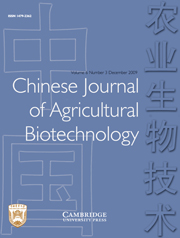Crossref Citations
This article has been cited by the following publications. This list is generated based on data provided by
Crossref.
Spigler, R B
Lewers, K S
Main, D S
and
Ashman, T-L
2008.
Genetic mapping of sex determination in a wild strawberry, Fragaria virginiana, reveals earliest form of sex chromosome.
Heredity,
Vol. 101,
Issue. 6,
p.
507.
Cadalen, T.
Mörchen, M.
Blassiau, C.
Clabaut, A.
Scheer, I.
Hilbert, J-L.
Hendriks, T.
and
Quillet, M-C.
2010.
Development of SSR markers and construction of a consensus genetic map for chicory (Cichorium intybus L.).
Molecular Breeding,
Vol. 25,
Issue. 4,
p.
699.
Sherman, J. D.
Weaver, D. K.
Hofland, M. L.
Sing, S. E.
Buteler, M.
Lanning, S. P.
Naruoka, Y.
Crutcher, F.
Blake, N. K.
Martin, J. M.
Lamb, P. F.
Carlson, G. R.
and
Talbert, L. E.
2010.
Identification of Novel QTL for Sawfly Resistance in Wheat.
Crop Science,
Vol. 50,
Issue. 1,
p.
73.
Cistué, L.
Cuesta-Marcos, A.
Chao, S.
Echávarri, B.
Chutimanitsakun, Y.
Corey, A.
Filichkina, T.
Garcia-Mariño, N.
Romagosa, I.
and
Hayes, P. M.
2011.
Comparative mapping of the Oregon Wolfe Barley using doubled haploid lines derived from female and male gametes.
Theoretical and Applied Genetics,
Vol. 122,
Issue. 7,
p.
1399.
Shahin, Arwa
Arens, Paul
Van Heusden, Adriaan W.
Van Der Linden, Gerard
Van Kaauwen, Martijn
Khan, Nadeem
Schouten, Henk J.
Van De Weg, W. Eric
Visser, Richard G. F.
and
Van Tuyl, Jaap M.
2011.
Genetic mapping in Lilium: mapping of major genes and quantitative trait loci for several ornamental traits and disease resistances.
Plant Breeding,
Vol. 130,
Issue. 3,
p.
372.
Tam, Sheh May
Hays, John B.
and
Chetelat, Roger T.
2011.
Effects of suppressing the DNA mismatch repair system on homeologous recombination in tomato.
Theoretical and Applied Genetics,
Vol. 123,
Issue. 8,
p.
1445.
BURRELL, A. MILLIE
TAYLOR, KATHERINE G.
WILLIAMS, RYAN J.
CANTRELL, ROBERT T.
MENZ, MONICA A.
and
PEPPER, ALAN E.
2011.
A comparative genomic map for Caulanthus amplexicaulis and related species (Brassicaceae).
Molecular Ecology,
Vol. 20,
Issue. 4,
p.
784.
Hizbai, Biniam T.
Gardner, K. M.
Wight, C. P.
Dhanda, R. K.
Molnar, S. J.
Johnson, D.
Frégeau‐Reid, J.
Yan, W.
Rossnagel, B. G.
Holland, J. B.
and
Tinker, N. A.
2012.
Quantitative Trait Loci Affecting Oil Content, Oil Composition, and Other Agronomically Important Traits in Oat.
The Plant Genome,
Vol. 5,
Issue. 3,
Rabbi, Ismail Yusuf
Kulembeka, Heneriko Philbert
Masumba, Esther
Marri, Pradeep Reddy
and
Ferguson, Morag
2012.
An EST-derived SNP and SSR genetic linkage map of cassava (Manihot esculenta Crantz).
Theoretical and Applied Genetics,
Vol. 125,
Issue. 2,
p.
329.
Rodríguez-Suárez, C.
Giménez, M. J.
Gutiérrez, N.
Ávila, C. M.
Machado, A.
Huttner, E.
Ramírez, M. C.
Martín, A. C.
Castillo, A.
Kilian, A.
Martín, A.
and
Atienza, S. G.
2012.
Development of wild barley (Hordeum chilense)-derived DArT markers and their use into genetic and physical mapping.
Theoretical and Applied Genetics,
Vol. 124,
Issue. 4,
p.
713.
Domínguez-García, M.C.
Belaj, A.
De la Rosa, R.
Satovic, Z.
Heller-Uszynska, K.
Kilian, A.
Martín, A.
and
Atienza, S.G.
2012.
Development of DArT markers in olive (Olea europaea L.) and usefulness in variability studies and genome mapping.
Scientia Horticulturae,
Vol. 136,
Issue. ,
p.
50.
Kongjaimun, Alisa
Kaga, Akito
Tomooka, Norihiko
Somta, Prakit
Shimizu, Takehiko
Shu, Yujian
Isemura, Takehisa
Vaughan, Duncan A.
Srinives, Peerasak
and
Scoles, G.
2012.
An SSR-based linkage map of yardlong bean (Vigna unguiculata(L.) Walp. subsp.unguiculataSesquipedalis Group) and QTL analysis of pod length.
Genome,
Vol. 55,
Issue. 2,
p.
81.
Bohra, Abhishek
Saxena, Rachit K.
Gnanesh, B. N.
Saxena, Kulbhushan
Byregowda, M.
Rathore, Abhishek
KaviKishor, P. B.
Cook, Douglas R.
and
Varshney, Rajeev K.
2012.
An intra-specific consensus genetic map of pigeonpea [Cajanus cajan (L.) Millspaugh] derived from six mapping populations.
Theoretical and Applied Genetics,
Vol. 125,
Issue. 6,
p.
1325.
Mbanjo, Edwige Gaby Nkouaya
Tchoumbougnang, François
Mouelle, Albert Sone
Oben, Julius Enyong
Nyine, Moses
Dochez, Carine
Ferguson, Morag Elizabeth
and
Lorenzen, James
2012.
Molecular marker-based genetic linkage map of a diploid banana population (Musa acuminata Colla).
Euphytica,
Vol. 188,
Issue. 3,
p.
369.
Guo, Wenjie
Tong, Jingou
Yu, Xiaomu
Zhu, Chuankun
Feng, Xiu
Fu, Beide
He, Shunping
Zeng, Fanzhen
Wang, Xinhua
Liu, Haiyang
and
Liu, Lusha
2013.
A second generation genetic linkage map for silver carp (Hypophthalmichehys molitrix) using microsatellite markers.
Aquaculture,
Vol. 412-413,
Issue. ,
p.
97.
Baltazar, Miriam D.
Ignacio, John Carlos I.
Thomson, Michael J.
Ismail, Abdelbagi M.
Mendioro, Merlyn S.
and
Septiningsih, Endang M.
2014.
QTL mapping for tolerance of anaerobic germination from IR64 and the aus landrace Nanhi using SNP genotyping.
Euphytica,
Vol. 197,
Issue. 2,
p.
251.
Honig, Josh A.
Kubik, Christine
Majewski, Martin
Poulsen, Christine
Weibel, Eric
Amundsen, Keenan
Warnke, Scott E.
Meyer, William A.
and
Bonos, Stacy A.
2014.
A PCR-based linkage map of Agrostis stolonifera and identification of QTL markers for dollar spot resistance.
Molecular Breeding,
Vol. 34,
Issue. 1,
p.
185.
Tang, Shiyi
Teng, Zhonghua
Zhai, Tengfei
Fang, Xiaomei
Liu, Fang
Liu, Dajun
Zhang, Jian
Liu, Dexin
Wang, Shunfeng
Zhang, Ke
Shao, Qianshun
Tan, Zhaoyun
Paterson, Andrew H.
and
Zhang, Zhengsheng
2015.
Construction of genetic map and QTL analysis of fiber quality traits for Upland cotton (Gossypium hirsutum L.).
Euphytica,
Vol. 201,
Issue. 2,
p.
195.
Ashkani, Sadegh
Rafii, Mohd Yusop
Shabanimofrad, Mahmoodreza
Foroughi, Majid
Azizia, Parisa
Akhtar, Mohd Sayeed
Sahebi, Mahbod
Harun, Abd Rahim
and
Nasehi, Abbas
2015.
Multiplex SSR–PCR approaches for semi-automated genotyping and characterization of loci linked to blast disease resistance genes in rice
.
Comptes Rendus. Biologies,
Vol. 338,
Issue. 11,
p.
709.
Kumar, Sushil
Hash, Charles T.
Thirunavukkarasu, Nepolean
Singh, Govind
Rajaram, Vengaldas
Rathore, Abhishek
Senapathy, Senthilvel
Mahendrakar, Mahesh D.
Yadav, Rattan S.
and
Srivastava, Rakesh K.
2016.
Mapping Quantitative Trait Loci Controlling High Iron and Zinc Content in Self and Open Pollinated Grains of Pearl Millet [Pennisetum glaucum (L.) R. Br.].
Frontiers in Plant Science,
Vol. 7,
Issue. ,


